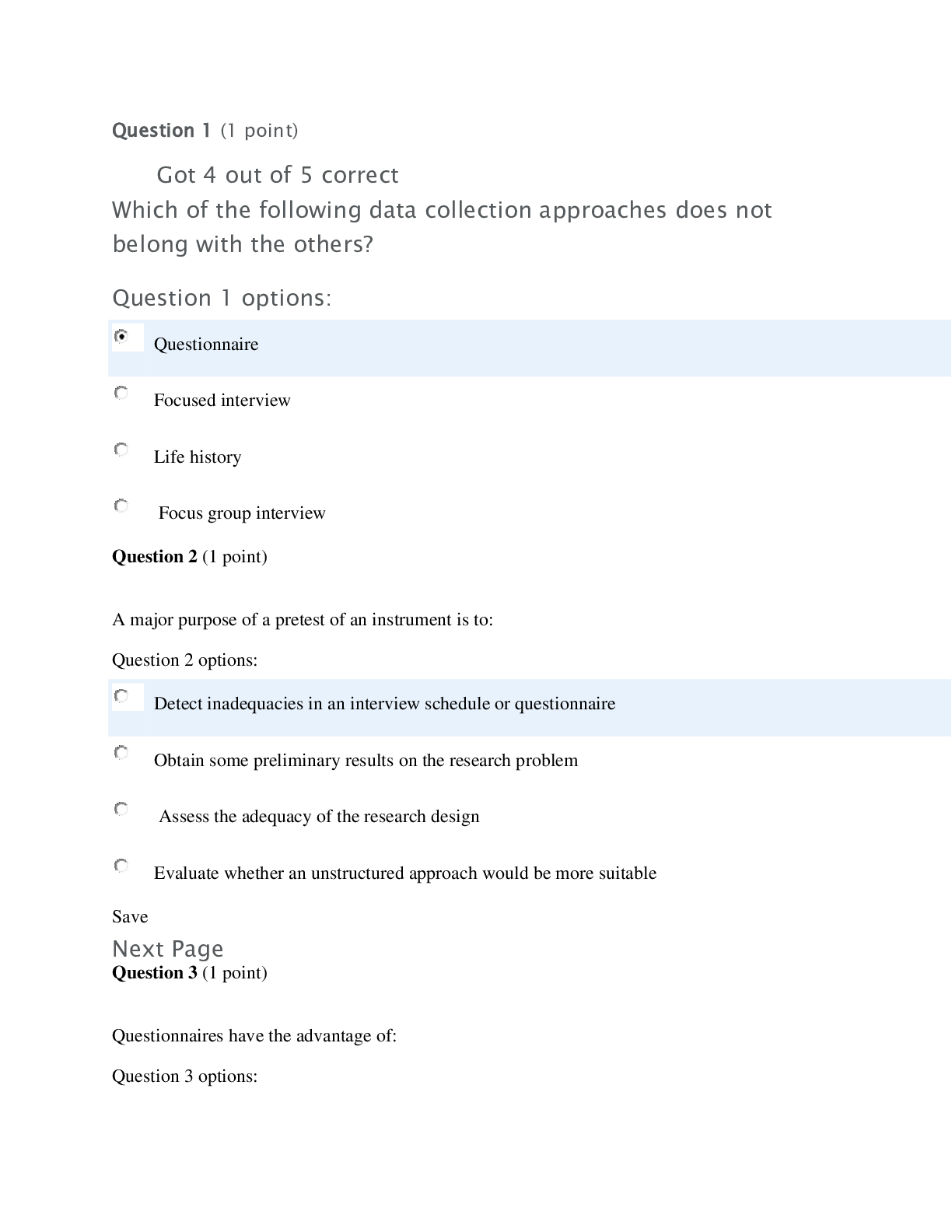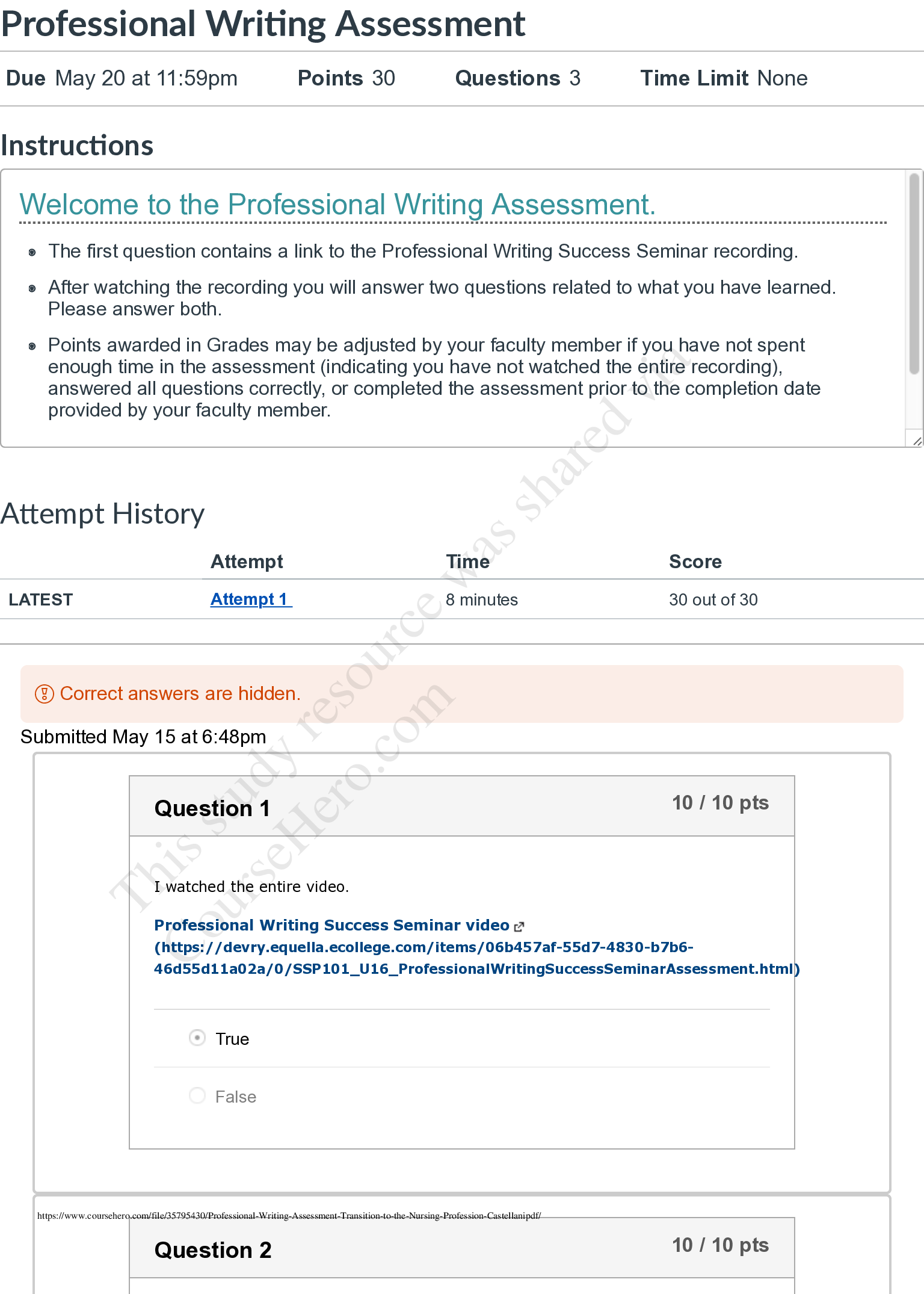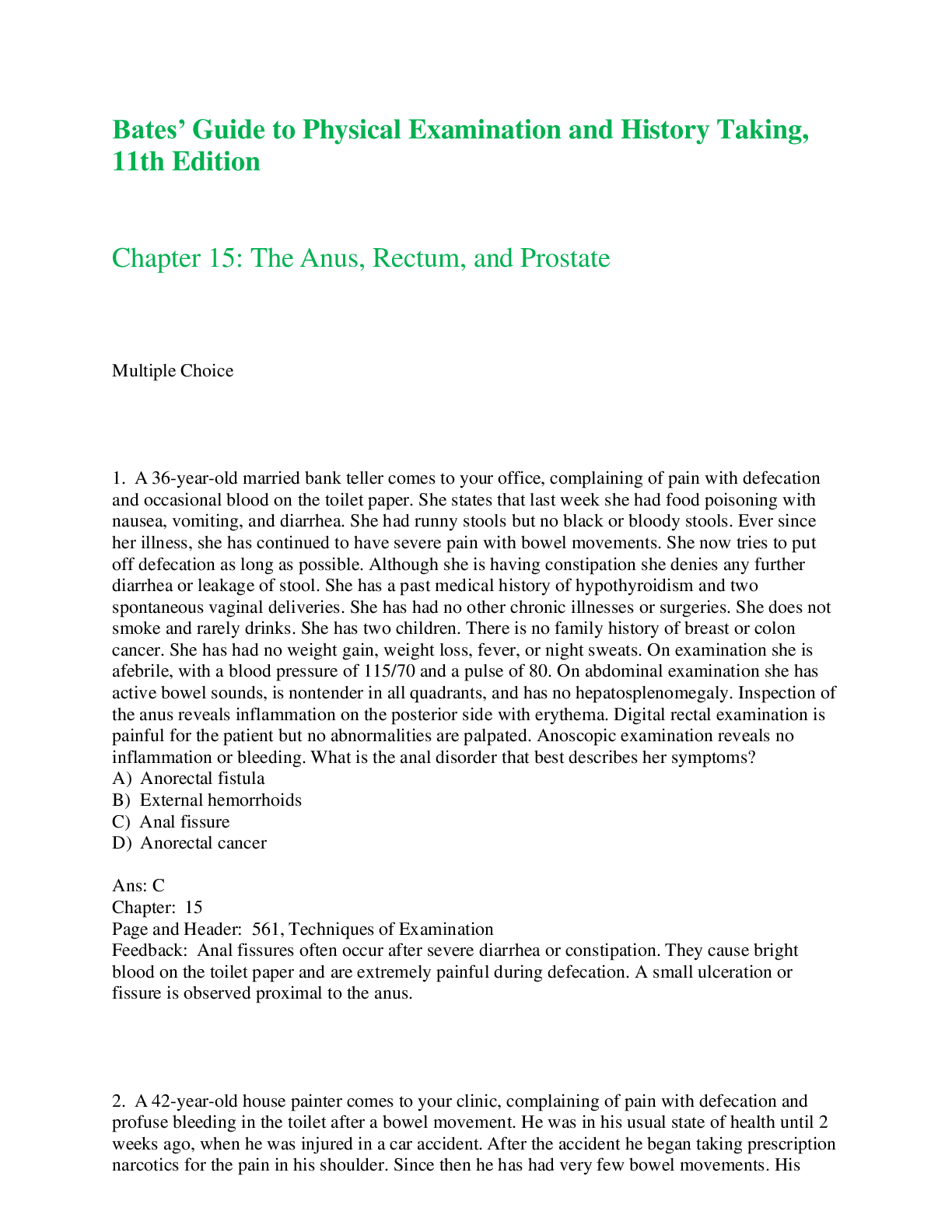*NURSING > EXAM > Bates’ Guide to Physical Examination and History Taking, 11th Edition Chapter 10: The Breasts and (All)
Bates’ Guide to Physical Examination and History Taking, 11th Edition Chapter 10: The Breasts and Axillae
Document Content and Description Below
Bates’ Guide to Physical Examination and History Taking, 11th Edition Chapter 10: The Breasts and Axillae Multiple Choice 1. A 72-year-old retired saleswoman comes to your office,... complaining of a bloody discharge from her left breast for 3 months. She denies any trauma to her breast. Her past medical history includes high blood pressure and abdominal surgery for colon cancer. Her aunt died of ovarian cancer and her father died of colon cancer. Her mother died of a stroke. The patient denies tobacco, alcohol, or drug use. She is a widow and has three healthy children. On examination her breasts are symmetric, with no skin changes. You are able to express bloody discharge from her left nipple. You feel no discrete masses, but her left axilla has a hard, 1-cm fixed node. The remainder of her heart, lung, abdominal, and pelvic examinations are unremarkable. What cause of nipple discharge is the most likely in her circumstance? A) Benign breast abnormality B) Breast cancer C) Galactorrhea Ans: B Chapter: 10 Page and Header: 392, The Health History Feedback: Nipple discharge in breast cancer is usually unilateral and can be clear or bloody. Although a breast mass is not palpated, in this case a fixed lymph node is palpated. Other forms of breast cancer can present as a chronic rash on the breast. 2. A 44-year-old female comes to your clinic, complaining of severe dry skin in the area over her right nipple. She denies any trauma to the area. She noticed the skin change during a self- examination 2 months ago. She also admits that she had felt a lump under the nipple but kept putting off making an appointment. She does admit to 6 months of fatigue but no weight loss, weight gain, fever, or night sweats. Her past medical history is significant for hypothyroidism. She does not have a history of eczema or allergies. She denies any tobacco, alcohol, or drug use. On examination you find a middle-aged woman appearing her stated age. Inspection of her right breast reveals a scaly eczema-like crust around her nipple. Underneath you palpate a nontender 2-cm mass. The axilla contains only soft, moveable nodes. The left breast and axilla examination findings are unremarkable. What visible skin change of the breast does she have? A) Nipple retraction B) Paget's disease C) Peau d'orange sign Ans: B Chapter: 10 Page and Header: 402, Techniques of Examination Feedback: This uncommon form of breast cancer starts as an eczema-like, scaly skin change around the areola. The lesion may weep, crust, or erode. It can be associated with an underlying mass, but the skin change can also be found alone. Any eczema-like area around the nipple that does not respond to topical treatment needs to be evaluated for breast cancer. 3. A 56-year-old female comes to your clinic, complaining of her left breast looking unusual. She says that for 2 months the angle of the nipple has changed direction. She does not do self- examinations, so she doesn't know if she has a lump. She has no history of weight loss, weight gain, fever, or night sweats. Her past medical history is significant for high blood pressure. She smokes two packs of cigarettes a day and has three to four drinks per weekend night. Her paternal aunt died of breast cancer in her forties. Her mother is healthy but her father died of prostate cancer. On examination you find a middle-aged woman appearing older than her stated age. Inspection of her left breast reveals a flattened nipple deviating toward the lateral side. On palpation the nipple feels thickened. Lateral to the areola you palpate a nontender 4-cm mass. The axilla contains several fixed nodes. The right breast and axilla examinations are unremarkable. What visible skin change of the breast does she have? A) Nipple retraction B) Paget's disease C) Peau d'orange sign Ans: A Chapter: 10 Page and Header: 402, Techniques of Examination Feedback: A retracted nipple is flattened or pulled inward or toward the medial, lateral, anterior, or posterior side of the breast. The surrounding skin can be thickened. This is a relatively late finding in breast cancer. 4. A 19-year-old female comes to your office, complaining of a clear discharge from her right breast for 2 months. She states that she noticed it when she and her boyfriend were “messing around” and he squeezed her nipple. She continues to have this discharge anytime she squeezes that nipple. She denies any trauma to her breasts. Her past medical history is unremarkable. She denies any pregnancies. Both of her parents are healthy. She denies using tobacco or illegal drugs and drinks three to four beers a week. On examination her breasts are symmetric with no skin changes. You are able to express clear discharge from her right nipple. You feel no discrete masses and her axillae are normal. The remainder of her heart, lung, abdominal, and pelvic examinations are unremarkable. A urine pregnancy test is negative. What cause of nipple discharge is the most likely in her circumstance? A) Benign breast abnormality B) Breast cancer C) Nonpuerperal galactorrhea Ans: A Chapter: 10 Page and Header: 392, The Health History Feedback: Nipple discharge in benign breast abnormalities tends to be clear and unilateral. The discharge is usually not spontaneous. This patient needs to be told to stop compressing her nipple. If the problem still persists after the patient has stopped compressing the nipple, further workup is warranted. 5. A 23-year-old computer programmer comes to your office for an annual examination. She has recently become sexually active and wants to be placed on birth control. Her only complaint is that the skin in her armpits has become darker. She states it looks like dirt, and she scrubs her skin nightly with soap and water but the color stays. Her past medical symptoms consist of acne and mild obesity. Her periods have been irregular for 3 years. Her mother has type 2 diabetes and her father has high blood pressure. The patient denies using tobacco but has four to five drinks on Friday and Saturday nights. She denies any illegal drug use. On examination you see a mildly obese female who is breathing comfortably. Her vital signs are unremarkable. Looking under her axilla, you see dark, velvet-like skin. Her annual examination is otherwise unremarkable. What disorder of the breast or axilla is she most likely to have? A) Peau d'orange B) Acanthosis nigricans C) Hidradenitis suppurativa Ans: B Chapter: 10 Page and Header: 402, Techniques of Examination Feedback: Acanthosis nigricans can be associated with an internal malignancy, but in most cases it is a benign dermatologic condition associated with polycystic ovarian syndrome, consisting of acne, hirsutism, obesity, irregular periods, infertility, ovarian cysts, and early onset type 2 diabetes. It is also known to correlate with insulin resistance. 6. A 43-year-old store clerk comes to your office upset because she has found an enlarged lymph node under her left arm. She states she found it yesterday when she was feeling pain under her arm during movement. She states the lymph node is about an inch long and is very painful. She checks her breasts monthly and gets a yearly mammogram (her last was 2 months ago), and until now everything has been normal. She states she is so upset because her mother died in her 50s of breast cancer. The patient does not smoke, drink, or use illegal drugs. Her father is in good health. On examination you see a tense female appearing her stated age. On visual inspection of her left axilla you see a tense red area. There is no scarring around the axilla. Palpating this area, you feel a 2-cm tender, movable lymph node underlying hot skin. Other shotty nodes are also in the area. Visualization of both breasts is normal. Palpation of her right axilla and both breasts is unremarkable. Examining her left arm, you see a scabbed-over superficial laceration over her left hand. Upon your questioning, she remembers she cut her hand gardening last week. What disorder of the axilla is most likely responsible for her symptoms? A) Breast cancer B) Lymphadenopathy of infectious origin C) Hidradenitis suppurativa Ans: B Chapter: 10 Page and Header: 402, Techniques of Examination Feedback: A lymph node enlarged because of infection is generally hot, tender, and red. Close examination of the skin that drains to that lymph node region is advised. Often there will be a cut or scratch over the involved arm that has an infectious agent. An example is cat scratch disease. 7. A 63-year-old nurse comes to your office, upset because she has found an enlarged lymph node under her right arm. She states she found it last week while taking a shower. She isn't sure if she has any breast lumps because she doesn't know how to do self-exams. She states her last mammogram was 5 years ago and it was normal. Her past medical history is significant for high blood pressure and chronic obstructive pulmonary disease. She quit smoking 2 years ago after a 55-packs/year history. She denies using any illegal drugs and drinks alcohol rarely. Her mother died of a heart attack and her father died of a stroke. She has no children. On examination you see an older female appearing her stated age. On visual inspection of her right axilla you see nothing unusual. Palpating this area, you feel a 2-cm hard, fixed lymph node. She denies any tenderness. Visualization of both breasts is normal. Palpation of her left axilla and breast is unremarkable. On palpation of her right breast you feel a nontender 1-cm lump in the tail of Spence. What disorder of the axilla is most likely responsible for her symptoms? A) Breast cancer B) Lymphadenopathy of infectious origin C) Hidradenitis suppurativa Ans: A Chapter: 10 Page and Header: 402, Techniques of Examination Feedback: Metastatic lymph nodes tend to be hard, nontender, and fixed, often to the rib cage. Although the patient has no family history of breast cancer, she is at a slightly increased risk due to her never having had children. 8. A 40-year-old mother of two presents to your office for consultation. She is interested in knowing what her relative risks are for developing breast cancer. She is concerned because her sister had unilateral breast cancer 6 years ago at age 38. The patient reports on her history that she began having periods at age 11 and has been fairly regular ever since, except during her two pregnancies. Her first child arrived when she was 26 and her second at age 28. Otherwise she has had no health problems. Her father has high blood pressure. Her mother had unilateral breast cancer in her 70s. The patient denies tobacco, alcohol, or drug use. She is a family law attorney and is married. Her examination is essentially unremarkable. Which risk factor of her personal and family history most puts her in danger of getting breast cancer? A) First-degree relative with premenopausal breast cancer B) Age at menarche of less than 12 C) First live birth between the ages of 25 and 29 D) First-degree relative with postmenopausal breast cancer Ans: A Chapter: 10 Page and Header: 393, Health Promotion and Counseling Feedback: Having a first-degree relative with cancer before menopause gives a relative risk of 3.1. 9. A 51-year-old cook comes to your office for consultation. She recently found out that her 44- year-old sister with premenopausal breast cancer is positive for the BRCA1 gene. Your patient has been doing research on the Internet and saw that her chance of having also inherited the BRCA1 gene is 50%. She is interested in knowing what her risk of developing breast cancer would be if she were positive for the gene. She denies any lumps in her breasts and has had normal mammograms. She has had no weight loss, fever, or night sweats. Her mother is healthy and her father has prostate cancer. Two of her paternal aunts died of breast cancer. She is married. She denies using tobacco or illegal drugs and rarely drinks alcohol. Her breast and axilla examinations are unremarkable. At her age, what is her risk of getting breast cancer if she has the BRCA1 gene? A) 10% B) 50% C) 80% Ans: B Chapter: 10 Page and Header: 393, Health Promotion and Counseling Feedback: At the age of 50, the risk of breast cancer for someone with the BRCA1 gene is 50%. 10. A 14-year-old junior high school student is brought in by his mother and father because he seems to be developing breasts. The mother is upset because she read on the Internet that smoking marijuana leads to breast enlargement in males. The young man adamantly denies using any tobacco, alcohol, or drugs. He has recently noticed changes in his penis, testicles, and pubic hair pattern. Otherwise, his past medical history is unremarkable. His parents are both in good health. He has two older brothers who never had this problem. On examination you see a mildly overweight teenager with enlarged breast tissue that is slightly tender on both sides. Otherwise his examination is normal. He is agreeable to taking a drug test. What is the most likely cause of his gynecomastia? A) Breast cancer B) Imbalance of hormones of puberty C) Drug use Ans: B Chapter: 10 Page and Header: 402, Techniques of Examination Feedback: Approximately one third of teenage boys develop gynecomastia during puberty. It is not surprising that the two older brothers did not have this. 11. A patient is concerned about a dark skin lesion on her anterolateral abdomen. It has not changed, and there is no discharge or bleeding. On examination there is a medium brown circular lesion on the anterolateral wall of the abdomen. It is soft, has regular borders, is evenly pigmented, and is about 7 mm in diameter. What is this lesion? A) Melanoma B) Dysplastic nevus C) Supernumerary nipple D) Dermatofibroma Ans: C Chapter: 10 Page and Header: 389, Anatomy and Physiology Feedback: This represents a supernumerary nipple. These occur along the “milk line” and do not exhibit features of more concerning lesions. 12. A 30-year-old man notices a firm, 2-cm mass under his areola. He has no other symptoms and no diagnosis of breast cancer in his first-degree relatives. What is the most likely diagnosis? A) Breast tissue B) Fibrocystic disease C) Breast cancer D) Lymph node Ans: A Chapter: 10 Page and Header: 389, Anatomy and Physiology Feedback: Approximately one third of adult men will have palpable breast tissue under the areola. While males can have breast cancer, this is much less common. There are no lymph nodes in this area. 13. Which of the following lymph node groups is most commonly involved in breast cancer? A) Lateral B) Subscapular C) Pectoral D) Central Ans: D Chapter: 10 Page and Header: 389, Anatomy and Physiology Feedback: The central nodes at the apex of the axilla are most commonly involved in breast cancer. The axilla can be viewed roughly as a four-sided pyramid. An examination covering all sides and the apex is unlikely to miss a significant node. 14. When should a woman conduct breast self-examination with respect to her menses? A) Five to seven days following her menses B) Midcycle C) Immediately prior to menses D) During her menses Ans: A Chapter: 10 Page and Header: 392, The Health History Feedback: The breast examination should be conducted during the time with the least estrogen stimulation of the breast tissue. This corresponds to five to seven days following menses. 15. Mrs. Patton, a 48-year-old woman, comes to your office with a complaint of a breast mass. Without any other information, what is the risk of this mass being cancerous? A) About 10% B) About 20% C) About 30% D) About 40% Ans: A Chapter: 10 Page and Header: 393, Health Promotion and Counseling Feedback: Eleven percent of women presenting with a breast mass will have breast cancer. This statistic can be reassuring to a patient, but the importance of further studies must be emphasized. 16. How often, according to American Cancer Society recommendations, should a woman undergo a screening breast examination by a skilled clinician? A) Every year B) Every 2 years C) Every 3 years D) Every 4 years Ans: C Chapter: 10 Page and Header: 393, Health Promotion and Counseling Feedback: The current recommendation for screening by breast examination is every 3 years. 17. Which of the following is most likely benign on breast examination? A) Dimpling of the skin resembling that of an orange B) One breast larger than the other C) One nipple inverted D) One breast with dimple when the patient leans forward Ans: B Chapter: 10 Page and Header: 402, Techniques of Examination Feedback: Asymmetry in size of the breasts is a common benign finding. The others are concerning for underlying malignancy. 18. Which is the most effective pattern of palpation for breast cancer? A) Beginning at the nipple, make an ever-enlarging spiral. B) Divide the breast into quadrants and inspect each systematically. C) Examine in lines resembling the back and forth pattern of mowing a lawn. D) Beginning at the nipple, palpate outward in a stripe pattern. Ans: C Chapter: 10 Page and Header: 402, Techniques of Examination Feedback: The vertical strip pattern has been shown to be the most effective pattern for palpation of the breast. The most important aspect, however, is to be systematic. The tail of Spence, located on the upper anterior chest, is an area commonly missed on examination. 19. Which is true of women who have had a unilateral mastectomy? A) They no longer require breast examination. B) They should be examined carefully along the surgical scar for masses. C) Lymphedema of the ipsilateral arm usually suggests recurrence of breast cancer. D) Women with breast reconstruction over their mastectomy site no longer require examination. Ans: B Chapter: 10 Page and Header: 402, Techniques of Examination Feedback: A woman who has had breast cancer remains at high risk for recurrence, especially in the contralateral breast. The mastectomy site should be carefully examined for local recurrence as well. Lymphedema or swelling of the ipsilateral arm following mastectomy is common and does not usually indicate recurrence. Women with breast reconstruction must also undergo careful examination. 20. Which of the following is true regarding breast self-examination? A) It has been shown to reduce mortality from breast cancer. B) It is recommended unanimously by organizations making screening recommendations. C) A high proportion of breast masses are detected by breast self-examination. D) The undue fear caused by finding a mass justifies omitting instruction in breast self- examination. Ans: C Chapter: 10 Page and Header: 402, Techniques of Examination Feedback: Although self-examination has not been shown to reduce mortality and is not recommended by all groups making screening recommendations, many choose to teach women a systematic method in which to examine their breasts. A high proportion of breast masses are detected by breast self-examination. [Show More]
Last updated: 1 year ago
Preview 1 out of 10 pages
Instant download

Buy this document to get the full access instantly
Instant Download Access after purchase
Add to cartInstant download
Reviews( 0 )
Document information
Connected school, study & course
About the document
Uploaded On
Apr 30, 2021
Number of pages
10
Written in
Additional information
This document has been written for:
Uploaded
Apr 30, 2021
Downloads
0
Views
57





.png)








.png)









